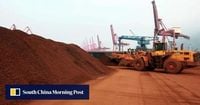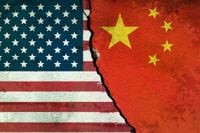Rare earth minerals—those obscure elements tucked away in the guts of everything from smartphones to fighter jets—have once again landed at the center of a global trade drama. In a flurry of high-stakes diplomacy, China announced a temporary suspension of some of its most punishing export controls, prompting cautious optimism but also a fair bit of confusion among its trading partners, especially in the United States and Europe.
Just days ago, U.S. Treasury Secretary Scott Bessent didn’t mince words in an interview with CNN. He sharply criticized China’s rare earth export controls and painted a picture of the U.S. and its allies scrambling to break free from Beijing’s grip. “And now this administration, we’re going to go at warp speed over the next 1-2 years, and we’re going to get out from under this sword that the Chinese have over us, and they have it over the whole world. And this time, we have rallied the allies,” Bessent declared, according to CNN. He accused previous U.S. administrations of being caught napping while China spent decades building its dominance in the sector. “They’ve been putting this plan together for 25, 30 years, and the US has been asleep at the switch,” he said.
The urgency is understandable. In October 2025, China introduced new export restrictions on rare earths—minerals crucial for defense systems, electric vehicles, and consumer electronics. The move triggered immediate alarm in Washington and among global manufacturers, who rely on steady access to these materials for national security and advanced technology supply chains. Bessent, speaking to the Financial Times, called Beijing’s decision a strategic miscalculation: “China has alerted everyone to the danger. They’ve made a real mistake.” He added, “It’s one thing to put the gun on the table. It’s another thing to fire shots in the air.”
The global reaction was swift. The Biden administration accelerated efforts to build independent supply chains, and Bessent noted that not just Western democracies, but Asian partners and India, were joining the push. “We don’t want to decouple from China, but we need to de-risk—they’ve shown themselves to be an unreliable partner in many areas,” he emphasized.
But then, in a dramatic turn at the Asia-Pacific Economic Cooperation (APEC) summit in Busan, South Korea, U.S. President Donald Trump and Chinese President Xi Jinping struck a deal. According to a White House announcement on November 3, 2025, China agreed to “effectively eliminate” the rare earth export restrictions imposed in October, as well as earlier curbs from April 2025 and even October 2022. The suspension also extends to the issuance of general licenses for exporting rare earths, gallium, germanium, antimony, and graphite—materials vital for U.S. end users and global supply chains.
The Trump administration, for its part, responded by suspending proposed 100% tariffs on Chinese goods and delaying other duties for one year. Trump, speaking to CBS News, boasted, “The U.S. has tremendous rare earth, and it is going to be a strength.” The new agreement, he said, would be renegotiated annually, aiming to keep both sides at the table and the market on edge.
Market watchers reacted instantly. Rare earth and minerals exchange-traded funds (ETFs) like VanEck Rare Earth/Strategic Metals surged 78.98% year-to-date, Global X Lithium & Battery Tech jumped 55.33%, and iShares U.S. Basic Materials climbed 10.93%, as reported by Benzinga. Investors, it seems, are betting that the scramble for supply will reshape the sector for years to come.
Yet, not everyone was convinced the crisis was over. The European Commission, speaking on November 3, 2025, expressed uncertainty about the extent of China’s suspension. Olof Gill, the Commission’s trade spokesperson, told reporters that Brussels’ “understanding” was that China would postpone the October restrictions for all trading partners, including the EU, but that no ironclad guarantees had been received. The October restrictions would have required export licenses for products containing even trace amounts of strategic metals and effectively banned their export for military use.
China’s commerce ministry did announce a twelve-month suspension of the October curbs, pledging to “study and refine specific plans” for the elements, which are used in everything from computers and electric vehicles to radars and fighter jets. EU Trade Commissioner Maroš Šefčovič confirmed on social media that the suspension applied to the EU, but earlier, less stringent controls from April—affecting seven of the 17 rare earth elements—were likely to remain in force. “We want there to be a stable and reliable trade supply of rare earth minerals and other critical inputs from China to the EU,” Gill said, but admitted that “ongoing contact, including at the political level” was needed to resolve the confusion.
Behind the scenes, European and Chinese trade officials met in Brussels on November 1, 2025, to hash out details. Both sides “discussed how to maintain supply chain stability in relation to rare earths and committed to further engage on licensing facilitation measures, including general licences,” according to official readouts. The European Automobile Manufacturers’ Association (ACEA) warned that “assembly line stoppages might only be days away” if the supply issues weren’t resolved, urging all parties to “redouble their efforts to find a diplomatic way out of this critical situation.”
The rare earth dispute is only part of a broader struggle over technology and supply chains. The EU automotive industry has been hit hard by shortages since the Dutch government took control of chipmaker Nexperia, a subsidiary of China’s Wingtech, in October 2025, citing governance concerns. China responded by imposing controls on chip exports, further disrupting European industry. After the Trump-Xi meeting, the White House reported that “China will take appropriate measures” to ensure the flow of chips from Nexperia’s facilities in China, which would “allow production of critical legacy chips to flow to the rest of the world.”
Henna Virkkunen, the EU’s Tech Commissioner, met with Nexperia officials on October 31, 2025, and reaffirmed the EU’s determination to work towards a diplomatic breakthrough. The EU is also evaluating its Chips Act, rules introduced in 2023 to boost Europe’s share of the global microchip market and strengthen supply chain resilience. “It is clear that our supply chain lacks the resilience required, and we must draw the necessary lessons,” Virkkunen remarked.
Veteran economist Jeremy Siegel, quoted by Benzinga, had earlier criticized the U.S. for not having a strategic reserve of rare earth materials to counter China’s dominance, calling the situation “scandalous.” Meanwhile, analysts Julian Evans–Pritchard and Leah Fahy warned that China’s gambit could backfire, as the U.S. and allies might retaliate by restricting access to key aviation components or software like Microsoft Windows, which underpins most Chinese computers.
For now, the world waits to see if China’s rare earth suspension marks the start of a lasting détente or just a temporary pause in a long-running contest for technological supremacy. One thing is clear: the scramble for rare earths has exposed just how fragile—and fiercely contested—the world’s supply chains have become.


